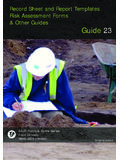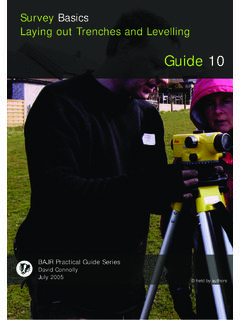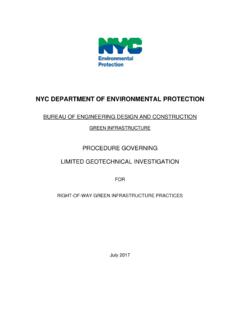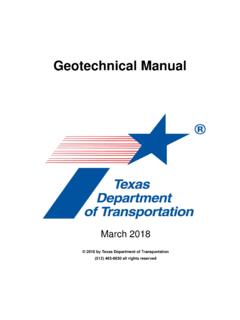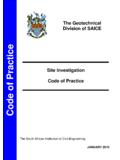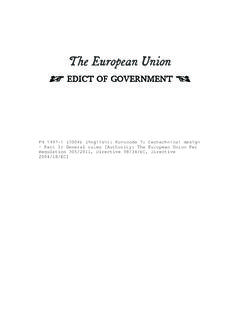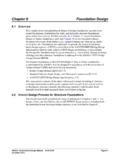Transcription of Geotechnical & Geoenvironmental Site Investigation - BAJR
1 Geotechnical & Geoenvironmental site InvestigationBAJR Practical Guide SeriesIAN FARMER ASSOCIATESF rigga Kruse, , PIFA 2006 Guide11 held by authorsWhat is site Investigation ? 1 What comprises site Investigation ? 1 Phase 1 Desk Study and site Reconnaissance 2 Phase 2 Intrusive Ground Investigation 3 Trial Pitting Window Sampling and Cable Percussive Boring Sampling Ground and Groundwater In-situ Tests in Trial Pits and Boreholes Laboratory Tests on Samples Description of Soils Report Contaminated sites 13 Different Phases of Investigation Trial Pits and Trenches Window Sampling Light Cable Percussion Boreholes On- site Testing Off- site Testing Report Implications for Archaeology The Definition of site Investigation 16 Phase 1 17 Phase 2 Intrusive Ground Investigation 17 Trial Pitting Window Sampling and Cable Percussive Boring Sampling In-situ tests and Laboratory tests Description of soils Report Contaminated sites 21 References 22 Geotechnical Siteworks.
2 October 2006 Geotechnical and Geoenvironmental site Investigation A Short Guide 1 Geotechnical and Geoenvironmental site Investigation What is a site Investigation ? In AClient s Guide to site Investigation the AGS (Association of Geotechnical and Geoenvironmental Specialists) states that adequate site Investigation is of importance to the civil engineer for the successful completion of any building project, The design of a structure which is economical and safe to construct, is durable and has low maintenance costs, depends upon an adequate understanding of the nature of the ground. This understanding comes from an appreciation of the distribution of the materials in the ground, and their properties and behaviour under various influences and constraints during the construction and lifetime of the structure. An adequate and properly structured site Investigation is therefore an essential part of any civil engineering or building project.
3 A site Investigation simply is the process of the collection of information, the appraisal of data, assessment, and reporting without which the hazards in the ground beneath the site cannot be known. What comprises a site Investigation ?The AGS realises that, the approach adopted for a particular site Investigation , its extent and the techniques used will all depend upon the site -specific circumstances, and the experience and judgment of those involved. There is no single way to carry out an Investigation , and inevitably different advisors will adopt different approaches for any particular project. However, it is usual for the site Investigation to be a phased exercise. For the purposes of this article, the site -specific circumstances encountered will be land-based residential, commercial and industrial developments at any scale as well as the occasional highway or pipeline project, and the experience of those involved will be my own after having worked as an engineering geologist and field archaeologist for a UK-based firm in recent years.
4 There is no point to discuss rotary drilling and rock core in much detail as this barely affects archaeology. Figure 1: JCB excavating test pit and cable percussion rig in foreground. Geotechnical Siteworks :: October 2006 Geotechnical and Geoenvironmental site Investigation A Short Guide 2No matter what the approach to a project, it invariably adheres to the BS 5930:1999 Code of practice for site investigations and the BS 10175:2001 Investigation of potentially contaminated sites Code of practice . The approach normally involves a Phase 1 desk study and site reconnaissance that includes the collection of information from maps, published documents, utility records, anecdotal evidence, aerial photographs, and walkover surveys, to reduce the risk of unpleasant surprises during the Phase 2 intrusive ground Investigation . The Phase 2 ground Investigation is usually undertaken using trial pits, boreholes, penetration tests, laboratory tests, and occasionally geophysical methods.
5 The intrusive Investigation is usually followed by the production of either factual or interpretative reports to clarify particular technical requirements and provide design and construction information to be incorporated into the design report. However, depending on the size of a project, other contractors may prefer to follow an initial Phase 2 Investigation with a more detailed Phase 3 Investigation to arrive at recommendations for the design report and continue with a Phase 4 Investigation to continually re-assess the assumed ground model during the actual construction period. Phase 1 Desk Study and site ReconnaissancePhase 1 starts with searching readily available archives and databases to produce a desk study report that firstly introduces the site setting: site location; site description; site walkover; Geological setting; Hydrogeological setting; Hydrological setting.
6 Furthermore, the report outlines the results of environmental searches such as: Waste treatment and disposal sites; Air pollution controls; Radioactive substances; Pollution incidents; Discharge consents; Green Belt areas; Designated sites; Nitrate vulnerable zones; Geological constraints; Coal mining report; Radon report. Earlier uses and state of the site such as underground mining, opencast mining, quarry operations, waste tips and landfills, industrial sites as well as ancient monuments and ecology should be discerned from: Geotechnical Siteworks :: October 2006 Geotechnical and Geoenvironmental site Investigation A Short Guide 3 All available OS maps; Recent changes; Contemporary trade directory entries. Firstly, the gathered information is used to clarify geological constraints and hazards such as: Slopes (landslides); Swelling and shrinking clays (heave or subsidence); Soluble rock (subsidence); Compressible or collapsible ground (excessive or uneven settlement); Running sand (problems with excavations, tunnelling; problems with irrigation, surface water disposal); Radon (naturally occurring radioactive gas that causes lung cancer); Methane and carbon dioxide (asphyxiants and explosive); Groundwater (flooding); Underground mining (stability).
7 Secondly, the gathered information is used to derive a conceptual site model of potentially contaminated land where a pollutant linkage between source and receptors such as humans, vegetation, water, and building materials may exist. Once all available information has been assessed and it is found that geological and environmental conditions need to be quantified, recommendations for further work commonly include the commissioning of a Phase 2 intrusive ground Investigation . Geotechnical Siteworks :: October 2006 Geotechnical and Geoenvironmental site Investigation A Short Guide 4 Phase 2 Intrusive Ground InvestigationThe selection of ground Investigation methods depends firstly on the characteristics of the ground, the objectives, and the technical requirements, but may be influenced by the character of the site , equipment, personnel, and costs. Trial pitting, window sample boreholes and light cable percussion boreholes are commonly used to recover soil samples.
8 The following are summarized method statements for each. Trial Pitting Using a complete set of service drawings, the engineer marks out and CAT scans all trial pit positions to avoid local underground and overhead services. A JCB 3CX with a 2ft toothed bucket, and occasionally a breaker to open hardstanding, positions itself adjacent to the first trial pit. Topsoil and turfs are stripped and stored separately from other excavated material and reused at the surface when reinstating. Jar samples are taken of the topsoil. Bulk samples are to be taken to enhance the soil profile, either every metre or, if more frequent, at every stratum change. The trial pits are excavated to an agreed depth of maximal about , or until the sides become unstable, an obstruction is encountered, or bedrock is reached. Following water strike, the flow and level are recorded over a 20-minute period.
9 Water samples are taken following a water strike. When the trial pit is complete, the engineer records and photographs all details regarding the trial pit. The trial pit is to be backfilled in reverse order, to which it was excavated and compacted to reduce later settlement. All steps are carried out for the remaining trial pits before the JCB is removed from site . Any damage to the site shall be reinstated on the way out. Figure 2: Engineer marking samples from test Siteworks :: October 2006 Geotechnical and Geoenvironmental site Investigation A Short Guide 5 Window Sampling and Cable Percussive Boring Awindow sampler is best suited for dry cohesive soils and can take a continuous sequence of sample tubes, usually 1m long and of variable diameter, down to a maximum depth of about 8m. Light cable percussion boring normally uses a mobile rig specially designed for ground work and suitable for recovering disturbed soil and weak rock samples to depths of about 60m.
10 Using a complete set of service drawings, the engineer marks out and CAT scans all borehole positions to avoid local underground and overhead services. The engineer gives the drilling crew instructions, detailing sampling, chiselling and installation requirements, and the rig is erected over the first borehole position. The drilling crew hand excavates an inspection pit to BGL to clear for buried services and surface obstructions after which drilling commences. The borehole is terminated at an agreed depth, or at an obstruction or bedrock, and a decision for rotary drilling, installation or grouting is issued. Where piezometer or standpipe are required the engineer instructs the driller as to the make up of the installation. The driller shall backfill the boreholes with the bentonite/cement grout mix. The rig is dismantled and the borehole site is made safe and tidy. All excess spoil to be bagged and removed from site and disposed to the appropriate landfill site .
